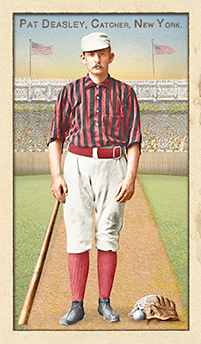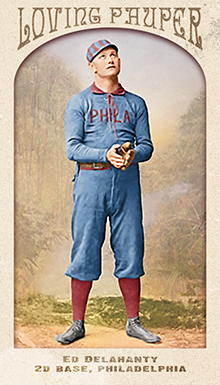
- Series: 1880s: Loving Paupers
- City: Philadelphia
- Team: Quakers
- League: National League
- Hall: National Baseball Hall of Fame
Edward James Delahanty (1867-1903) died in the icy waters of the Niagara River while still in his baseball prime. He was hitting .333 for the Senators that July of 1903, well below his days with the Phillies, but still a force to be reckoned with after a 16-year career in left field. Through the 1890s no hitter dominated as did Big Ed. With Sam Thompson and Billy Hamilton he formed an outfield-for-the-ages, each hitting .400+ in 1894. He struggled during his early years until, driven to excel, Ed transformed himself at the plate. Personal achievement had not brought a pennant, however, and Delahanty experienced the frustrations of the reserve system in his pursuit of the pay he felt was his due. As with so many players of that day, Ed turned to the bottle and was given to outbursts such as the one that got him ejected from the train the night he died. His tragic end came amid one of the great careers in baseball history.
- Only player to win batting titles in both AL & NL
- First to hit .400 three times
- Fifth all-time in career batting average (.346)
- 2nd player to hit 4 HRs in a game
- Elected to Hall of Fame: 1945
Auction History
Cartophilia
Old Judge Pose: 123-3
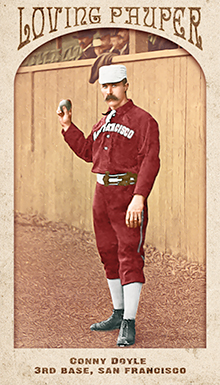
- Series: 1880s: Loving Paupers
- City: San Francisco
- Team: Haverlys
- League: California League
Cornelius J. Doyle (1862-1931) was an Irish immigrant who played outfield for two seasons in the major leagues. He was with the early forerunner to today’s Phillies, the Quakers, in 1883. He had one more attempt at staying at the top of his profession with the Pittsburgh Alleghenys of the American Association in 1884. The AA lasted for a decade following its founding in ‘82. The Alleghenys would eventually morph into today’s Pirates. Conny’s tenure was brief and his stints with both clubs equally so. He saw action in 16 games for the Quakers and 15 for Pittsburgh. He sported an anemic .221 average in his rookie campaign, but finished with a flourish as he hit .293 with the Alleghenys.
Doyle had begun at the pinnacle of baseball, the National League, in ‘83 as a twenty-one year old. His poor batting sent him down to the Northwestern League’s Quincy (IL) Quincys in 1884 where his fine .304 average earned him the next shot with Pittsburgh later that year. He led the Quincys with four home runs playing aside ten other future major leaguers, including Ice Box Chamberlain and Kid Baldwin. Doyle knocked around the minors for the next decade, playing regularly for the likes of the Lynn (MA) Shoemakers, Atlanta Atlantans, Peoria Canaries and the New Haven Nutmegs. In 1889 Conny was captured by photographers in his San Francisco Haverlys uniform during a brief west coast assignment. He closed his pro career with two widely-dispersed teams in 1893: the Dover club of the New England League and the New Orleans Pelicans of the Southern Association. This young immigrant found baseball an ideal vehicle to tour his adopted land.
- At age 31 Doyle was far from the grizzled veteran of the Pelican squad. Dick Phelan was 38 and two other teammates were senior to Conny
- One of those teammates was Kid Baldwin, indicating the twists and turns of pro ball in the 19th century. The Kid and Conny were rookies in Illinois and followed very different routes in their respective careers, but both found themselves closing out their baseball lives with the same New Orleans franchise in 1893
Auction History
Cartophilia
Old Judge Pose: 133-1
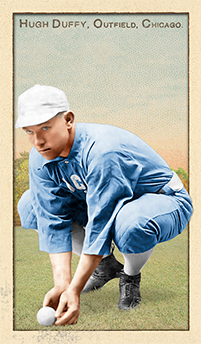
- Series: Beginnings: 1880's
- City: Chicago
- Team: White Stockings
- League: National League
- Hall: National Baseball Hall of Fame
Hugh Duffy (1866-1954) is as much a baseball institution as the Hall of Fame that enshrines him. For 68 years he devoted himself to the game he loved and excelled at as few ever have. In 1894 he set the all-time mark with a .440 average while winning the triple crown. He made HOF pitchers look like batting practice coaches: .586 against John Clarkson, .650 vs Cy Young. Amos Rusie was the exception, holding Duffy to a mere .333. So diminutive Cap Anson nearly dismissed him (“We already have a bat boy”), Hugh hustled his way to becoming the only player to hit .300 in four leagues and let the power follow his form (“hit ‘em up the middle”) winning two HR titles. Duffy went on to coach, manage, scout and mentor for a half-century after hanging up his spikes. He was still hitting fungoes eight years after his induction into Cooperstown and delighted in pupil Ted Williams’ success as he sought in vain to eclipse Duffy’s record in 1941.
- Playing career spanned 19 years, primarily in Chicago, Boston and Philadelphia
- Played center field for the Beaneaters next to his “Heavenly Twin,” Tommy McCarthy in right, leading Boston to a pair of pennants
- Elected to Hall of Fame: 1945
- Series: Beginnings: 1880's
- City: New York
- Team: Giants
- League: National League
Thomas H. Deasley (1857-1943) was a catcher for eight years for four ML clubs: the Boston Red Caps, St Louis Browns, NY Giants and Washington Statesmen from 1881 through ’88. This Irish immigrant compiled a .244 BA and did not hit a home run in the “Dead Ball” era.
- Pat’s best year was 1887 with the Giants, hitting .314 with a .367 OBP
- That NY team was noted for being nearly all Irish: Mike Dorgan, Pete Gillespie and Jim O’Rourke were the OF, while all but 2 innings in ’85 were pitched by Irishmen for example
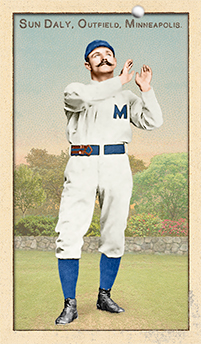
- Series: Beginnings: 1880's
- City: Minneapolis
- Team: Millers
- League: Western Association
James J. Daly (1865-1938) compiled a very short major league slash line. Sun made it to the big leagues with the Baltimore Orioles in 1892, joining one of the more ferocious teams of the era. He got into a mere 13 games and went 12-48 for a .250 average with seven RBI for the last-place team. With the likes of McGraw, Hanlon, Stovey and Wilbert Robinson - this was a down year for a team on the cusp of greatness. Already the squad was known for making its own rules and playing with a snarl. Thus, it was unlikely for a new kid to make the big club and Daly soon found himself back in the minors. He had begun playing ball in his hometown of Port Henry, NY and moved into the professional ranks with Portsmouth of the New England League in 1888. The next year he was out west with two Twin Cities clubs where he was photographed by the Old Judge crew. The Goodwin editors note that Daly was the poorest-fielding left fielder in the Western Association at that time. He returned east with Portland and Lebanon in '91 and began the '92 campaign with the Buffalo Bisons of the Eastern League. It is said that Daly acquired his nickname in the Buffalo outfield as he played the position while eschewing sun glasses. His distinctive moniker not enough to gain a toe-hold with the Orioles, Sun shuffled back to Buffalo for the '93-94 seasons. Daly then moved to Rochester for two years before wrapping it up in 1897 with stints for three Pennsylvania franchises: Reading, Scranton and Wilkes-Barre.
- Sun's best year at the plate was 1895 with Rochester where he hit .337 in 128 games, by far his most prolific season
- While his endurance at the pinnacle of his sport was short-lived, Daly set a much finer life-mark by living just long enough to celebrate fifty years of marriage to the mother of their four children



